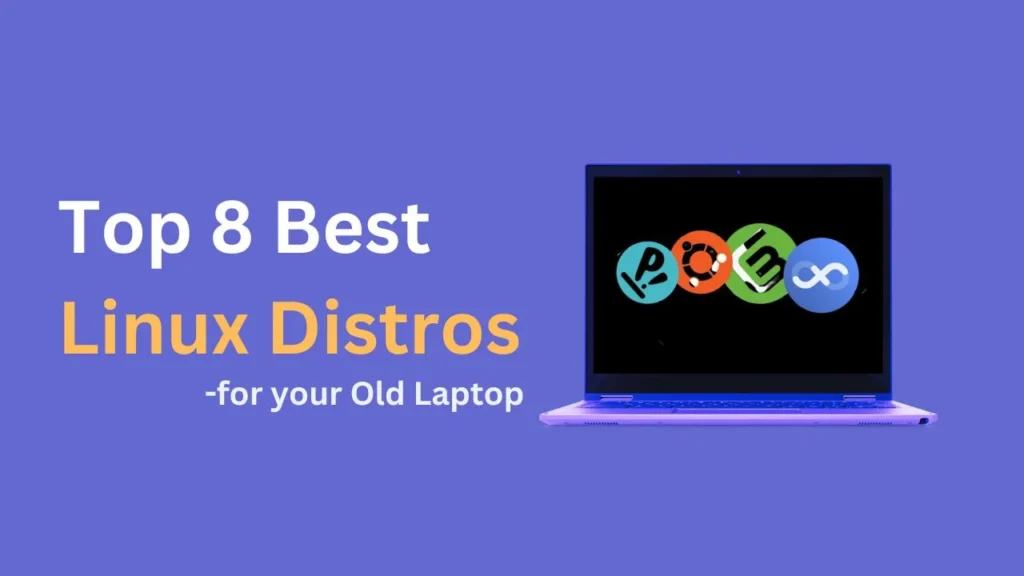Is your trusty laptop lumbering under the weight of bloated software and outdated operating systems? Don’t relegate it to the dustbin just yet! Lightweight Linux distros can rejuvenate your aging machine, transforming it from a sluggish relic into a nimble productivity powerhouse.
So, before you succumb to the siren song of a new device, check out these top 8 best Linux distros for reviving your old laptop:

Table of Contents
1. Xubuntu
Feeling nostalgic for Windows? Xubuntu’s familiar interface and extensive software library make it a smooth transition. Efficient with RAM, it breathes life into older machines while offering user-friendly productivity tools.
Pros
- User-friendly interface.
- Familiar for Windows users.
- Extensive software library.
- Efficient RAM usage.
Cons
- May not feel as snappy as some lighter options.
Specs:
- 32-bit: Minimum 512MB RAM, 8GB storage.
- 64-bit: Minimum 1GB RAM, 16GB storage.
2. Puppy Linux
Incredibly lightweight, Puppy boots from your RAM for blazing speed! Portable on a USB stick and boasting a vast community-built package library, it’s the ultimate underdog, even for older hardware.
Pros
- Incredibly lightweight.
- Boots from RAM (fast!).
- Portable on USB.
- Vast array of community-built packages.
Cons
- Interface may feel dated.
- Limited hardware compatibility for newer laptops.
Specs:
- 32-bit & 64-bit.
- Minimum 256MB RAM and 4GB storage.
3. Linux Lite
Windows users, rejoice! Linux Lite’s familiar interface makes installation a breeze. Pre-loaded with essential software and offering rolling release updates, it keeps things simple and current.
Pros
- Familiar Windows-like interface.
- Easy installation.
- Pre-loaded with essential software.
- Rolling release updates.
Cons
- Can be resource-intensive for older laptops with very limited RAM.
Specs:
- 32-bit: Minimum 1GB RAM, 8GB storage.
- 64-bit: Minimum 2GB RAM, 16GB storage.
4. Zorin OS Lite
Beauty and brains? Zorin OS Lite delivers. Its polished interface and excellent Windows compatibility tools make it a joy to use. Community support is top-notch, but resource usage might require some tweaking on older machines.
Pros
- Beautiful, polished interface.
- Excellent Windows compatibility tools.
- Good community support.
Cons
- Not as lightweight as some other options.
- Might require some tweaking for optimal performance.
Specs:
- 32-bit & 64-bit.
- Minimum 1GB RAM and 8GB storage.
5. Lubuntu
Efficiency is Lubuntu’s middle name. This lightweight champ uses the LXQt desktop for snappy responsiveness, even on limited resources. Software selection may be smaller than Ubuntu-based distros, but its user-friendliness shines.
Pros
- Very lightweight and efficient.
- LXQt desktop environment is responsive and user-friendly.
Cons
- Software selection may be smaller than Ubuntu-based distros.
Specs:
- 32-bit: Minimum 512MB RAM, 8GB storage.
- 64-bit: Minimum 1GB RAM, 16GB storage.
6. Bodhi Linux
Love customization? Bodhi’s lightweight desktop is your playground. Ideal for older machines with limited muscle, it can be challenging for beginners due to minimal pre-installed software. But for tech-savvy tinkerers, it’s a dream come true.
Pros
- Highly customizable lightweight desktop.
- Excellent for older machines with limited resources.
Cons
- Can be challenging for Linux beginners.
- Limited pre-installed software.
Specs:
- 32-bit & 64-bit.
- Minimum 256MB RAM and 5GB storage.
7. antiX
Rock-solid stability? antiX, based on Debian Stable, delivers. Useful rescue tools and good hardware compatibility make it a reliable companion for older laptops. Just don’t expect a flashy interface or to power through demanding tasks.
Pros
- Based on Debian Stable for exceptional stability.
- Includes useful rescue tools.
- Good hardware compatibility.
Cons
- Interface may feel outdated.
- Not ideal for demanding tasks.
Specs:
- 32-bit & 64-bit.
- Minimum 256MB RAM and 5GB storage.
8. Tiny Core Linux
Micro machine? Tiny Core Linux is your match! This ultra-lightweight distro (under 100MB!) uses a modular design for minimal resource usage. Ideal for older netbooks, it requires technical knowledge for configuration and offers limited graphical applications.
Pros
- Extremely lightweight (under 100MB!).
- Modular design for minimal resource usage.
- Ideal for older netbooks.
Cons
- Requires more technical knowledge for configuration.
- Limited graphical applications.
Specs:
- 32-bit & 64-bit.
- Minimum 512MB RAM and 4GB storage.
Beyond the Specs:
Choosing the right distro depends on your specific needs and comfort level. Consider what tasks you’ll be using your laptop for, your familiarity with Linux, and the hardware limitations of your machine. Don’t be afraid to try out a few different distros with Live CDs or virtual machines before committing.
Remember:
Even with a lightweight distro, some old laptops might still struggle with heavier tasks like video editing or gaming. But for basic web browsing, office work, email, and multimedia, these distros can work wonders. So, give your old laptop a second chance! You might be surprised at what it can still do with the right OS under the hood.
Conclusion
Before saying goodbye to your aging laptop, consider the magic of lightweight Linux distros. They can turn your sluggish relic into a nimble productivity powerhouse. Explore the top 8 options mentioned above, find the perfect fit, and give your old laptop a second chance.
Have you tried any of these Linux distros? Share your thoughts and recommendations in the comments below. Your experience might inspire others on their journey to revive their laptops.

Lubuntu and xubuntu only support 64 bit